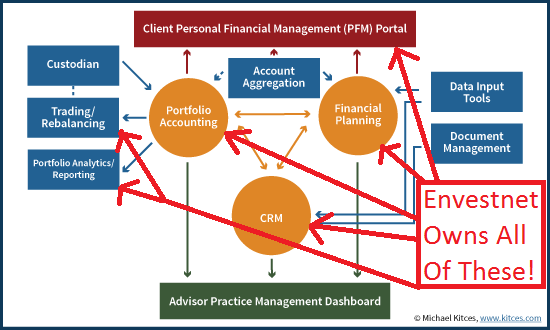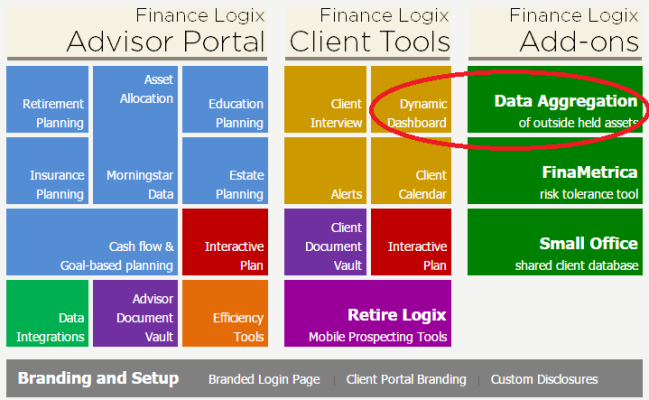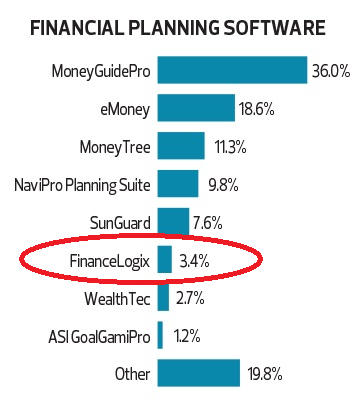Executive Summary
As the Envestnet Advisor Summit gets underway today, CEO Jud Bergman kicked off the event with the big news that financial planning software and PFM provider FinanceLogix is being acquired in a deal reported at $32.5M of cash and stock, plus significant additional options to the upside. The news comes on the heels of Envestnet's acquisition of robo-advisor-for-advisors Upside Advisor just a few months ago.
Relative to other recent deals like Fidelity's acquisition of eMoney Advisor and the Northwestern Mutual purchase of LearnVest - both rumored to be bought for more than $250M each - the FinanceLogix deal is noticeably smaller, but given that the company may have only had 1/5th the market share of eMoney Advisor, seems reasonably in line and suggests that the acquisition interest in integrated financial planning and PFM software solutions remains strong. In fact, with the FinanceLogix purchase, there are virtually no remaining fully integrated planning-plus-PFM solutions available today... so expect to see the major players begin to acquire standalone PFM solutions and 'manually' integrate them instead as the buying frenzy continues.
From the perspective of FinanceLogix, the Envestnet acquisition will give them significant resources to continue to build and iterate the software - which will remain available to existing and new standalone users, even as it is more fully integrated into the Envestnet Advisor Suite. And from the Envestnet perspective, the acquisition suggests that Envestnet is aiming to build the "Holy Grail" of advisor technology platforms, a fully integrated technology stack including CRM, portfolio accounting, and now financial planning software, integrated with a "robo"-style client-facing portal that includes PFM capabilities... and revealing that perhaps Envestnet is not positioning to someday become a competing custodian, but instead simply wants to take the high ground of advisor value-add and deliver the ultimate integrated technology platform of the future for advisors - one that can be used regardless of their underlying (and increasingly commoditized) custodian or broker-dealer relationship.
Envestnet Acquires FinanceLogix Financial Planning Plus PFM Software
As this week's 2015 Envestnet Advisor Summit gets underway, the big announcement is that Envestnet has acquired financial planning software provider FinanceLogix. The acquisition, which was first reported on RIABiz (with staff reporter Lisa Shidler on site at the event to break the news on the announcement), was also publicly reported by Envestnet in Form 8-K, and has Envestnet buying FinanceLogix for $24M in cash, plus 123,410 shares of Envestnet (ENV) common stock, which at a current closing price of approximately $52/share, puts the deal at approximately $30.4M. The deal also includes 10-year options to buy another 123,410 shares of Envestnet stock at $52.67, and FinanceLogix founder Oleg Tishkevich will be eligible for an earn-out over the next three years contingent on meeting certain (undisclosed at this time) financial targets and continued employment with Envestnet as their Managing Director and Chief Technology Officer of Financial Planner. RIABiz reports the earn-out deal structure to include almost $1.9M of additional Envestnet stock, plus some amount of cash and additional options as well. Assuming financial targets are met with continued growth, this effectively prices the FinanceLogix deal at approximately $32.5M plus options upside on Envestnet common stock.
In terms of the software itself, it's notable that FinanceLogix offered not only a core financial planning software solution, but also included a client portal with integrated account aggregation capabilities - in other words, similar to other recent high-profile deals like the Fidelity acquisition of eMoney Advisor just a few months ago, and also the recent Northwestern Mutual acquisition of LearnVest, FinanceLogix was yet another one of a rapidly shrinking set of solution that included both financial planning software and a PFM (Personal Financial Management) client dashboard. Which means that integrated PFM solutions for advisors continues to be the "hot" category of Advisor FinTech, as predicted several years ago.
On the other hand, relative to the size of recent advisor software acquisitions, the FinanceLogix deal was noticeably smaller than the others in recent news. Both the eMoney Advisor and LearnVest deals were reportedly priced at over $250M, while the FinanceLogix deal was "just" about $32.5M plus options, despite RIABiz' report that FinanceLogix had 20,000 advisor users. And while the recent Financial Planning Magazine Tech Survey of advisors had FinanceLogix at just a 3.4% market share - which is about 1/5th the market share of eMoney - it was purchased for about 1/8th the price, suggesting that perhaps the 20,000 user count reported by RIABiz represents enterprise bulk license purchases but that actual usage of FinanceLogix by advisors was/is somewhat lower.
However, given that eMoney was reportedly acquired for a premium as much as 4X revenues - enhanced perhaps by the unique strategic opportunities that Fidelity has to leverage eMoney Advisor across the entire enterprise) - and that LearnVest was bought for over $250M despite having no (advisor) revenue tied to its software (and a core business that was in the red) but again had strong potential to be leveraged across the entire Northwestern Mutual agent salesforce, perhaps FinanceLogix was simply purchased for a "healthy" price but not one with a big "strategic premium" attached. Though if you assign some value to the upside potential of the options and other earn-out payments that were included in the deal - the company's stock has gone from $10/share to over $50/share in the past 5 years! - it appears the terms of the FinanceLogix deal may have been entirely in-line with the eMoney purchase after all.

Envestnet - Investment Outsourcing Value-Adds Or "Holy Grail" Unified Technology Platform For All Custodians And Brokers-Dealers?
From the Envestnet perspective, the FinanceLogix purchase is just one of a long series of acquisitions the company has engaged in, from the $54M Tamarac rebalancing software purchase back in 2012 (now the #2 rebalancing solution for advisors), to its recent acquisition of "robo-advisor-for-advisors" solution Upside Advisor in March, Envestnet continues to morph from being "just" an investment outsourcing solution used primarily by broker-dealers, to a massive integrated technology platform for advisors. And indeed, Envestnet CEO Jud Bergman was quoted at the Envestnet Advisor Summit as emphasizing that the purpose of the FinanceLogix acquisition was specifically to tightly integrate financial planning software into its existing investment planning platform - no doubt after the success of doing similar deep integrations with Tamarac's rebalancing and CRM solutions over the past several years.
On the other hand, with the Envestnet acquisition of an integrated planning software solution coming directly on the heels of Fidelity's own deal, this Envestnet purchase is likely to continue raising the question of whether it is ultimately angling to be a competing custodial platform to solutions like Fidelity and Schwab... or alternatively, whether it is aiming to leapfrog the heavily commoditized custodian and clearing business and instead just focus on being an integrated technology platform that can overlay any of them. In other words, why would Envestnet become or compete with a custodian (or broker-dealer) that has to rely on technology as value-added solutions to their commoditized businesses, when it can simply build a centralized fully integrated technology platform and aim to become the holistic advisor technology platform of choice for any advisor at any broker-dealer or custodian?
In essence, the FinanceLogix acquisition goes a long way towards suggesting that Envestnet is well underway in its transition from "just" being an investment outsourcing platform to building the so-called "holy grail" of advisor technology - a CRM, portfolio accounting and reporting, and financial planning software solution, all fully integrated in a centralized platform, with a "robo-advisor-for-advisors" client-facing portal. In this context, Envestnet would not "just" be about providing outsourced investment management solutions, but the entire technology platform on which advisors run their businesses, avoiding the lower-margin custodian and broker-dealer business while simultaneously cutting off the ability of those custodians and broker-dealers to move up the value chain themselves! This is a bit of a contrast to Fidelity, which appears to have bought eMoney not "just" to offer to advisors or bolster its Fidelity Institutional offering for independent RIAs, but primarily to leverage its PFM solution across the entire Fidelity enterprise (think: millions of Fidelity 401(k) investors gaining access to an eMoney PFM portal so Fidelity can gain big data insights into everything from investor behavior to opportunity for cross-selling other Fidelity solutions, and Fidelity retail branch advisors using eMoney planning tools with walk-in clients).

Is Envestnet Trying To Build The Holy Grail Unified Advisor Technology Stack?
However, the notable caveat to Envestnet's apparent pursuit of the Holy Grail is that, as with the tale of the Holy Grail itself, it still remains unclear whether the vision can be fulfilled. The largest "other" Holy Grail solution available today, Sungard's WealthStation (used predominantly in advisor enterprise channels like broker-dealers, insurance companies, and banks), has long faced criticism that in its efforts to build a fully integrated platform, its individual offerings have struggled to keep up with the relentless pace of technology development. In other words, the "risk" of trying to sustain an integrated Holy Grail solution is that in practice, companies that try to build "everything" often end out being mediocre in every category, and lose out to best-in-class standalone solutions that more loosely integrate with each other (especially with the rise of APIs that make standalone advisor software solutions increasingly integrated anyway). Thus far, Envestnet's success with Tamarac's CRM, portfolio accounting, and rebalancing capabilities, suggests that it may be able to keep acquisition high-quality software solutions and integrating them into the Holy Grail... and advisors will often accept a slightly less capable software tool in exchange for a solution that is more fully integrated. But to say the least, Envestnet will certainly have its work cut out to sustain an array of fully integrated solutions while keeping each at a competitive "best-in-class" level going forward.
The Rapidly Shrinking Landscape Of Available Financial Planning Software Companies
As with the eMoney acquisition by Fidelity, the Envestnet announcement of the FinanceLogix purchase was immediately followed by comments from Envestnet leadership noting that FinanceLogix will continue to be supported on a standalone basis for existing and new advisors... while simultaneously being integrated into a more holistic version of the (Envestnet) wealth management platform. So in terms of available financial planning software to advisors, it's still "business as usual" for FinanceLogix, but anticipate some very deep integrations coming in the next year or two between FinanceLogix and the Envestnet Advisor Suite including Tamarac CRM and portfolio solutions.
In fact, it wouldn't be surprising to see a lot of big new developments come from FinanceLogix in the next year or two, as founder Oleg Tishkevich has long been visionary on financial planning software. FinanceLogix was one of the first solutions, over 10 years ago, to build in sliders that would allow advisors to do real-time collaborative planning interactively with their clients. It will be interesting to see what Tishkevich does to build out his vision of the planning software of the future, now that he has the opportunity to leverage Envestnet resources.
From the perspective of financial planning software companies available to acquire and be deeply integrated to an existing firm or used on a proprietary basis, though, the FinanceLogix acquisition continues to shrink what was already a very small pool of companies available today - especially those with integrated PFM capabilities. As noted earlier, eMoney Advisor and LearnVest are already off the market now. Market leader MoneyGuidePro remains privately held by founder Bob Curtis, but MGP has deliberately pursued a strategy of not building its own PFM solution and simply openly integrating with any/all of those available. Advicent - owners of NaviPlan financial planning software (and also Financial Profiles) - has also never built a PFM solution, although with its own acquisition of Figlo last fall, make ultimately be aiming to bring the Figlo PFM tools here to the US in the coming year. Of the remaining financial planning software solutions, MoneyTree never had a full PFM solution, nor does InStream or WealthTec; Sungard reporting has a 'light' PFM offering, though not of the depth of solutions like eMoney Advisor, and already fully bundled into its existing platform (so not likely to be acquired for its financial planning and PFM software "parts").
Which means for any future acquirers that are trying to "catch up" on technology - e.g., other large financial services companies that want to leverage financial planning plus PFM software solutions for their advisors or build out a more holistic advisor technology platform or their own "Holy Grail" solution - it appears the only choice going forward will be to build entirely from scratch, or to acquire and "manually" integrate one of the small handful of standalone PFM solutions like Wealth Access, Guide Financial, or perhaps even FlexScore (which uses PFM integration to deliver its recommendations) or more investment-centric solutions like Aqumulate or Blueleaf. My guess - it won't be long until you start seeing some of the independent PFM software solutions get gobbled up, too, as the Advisor FinTech buying frenzy continues as the hot trend for 2015.
(Disclosure: Michael Kitces has an Advisory Board relationship with Guide Financial, which was mentioned in this article.)






